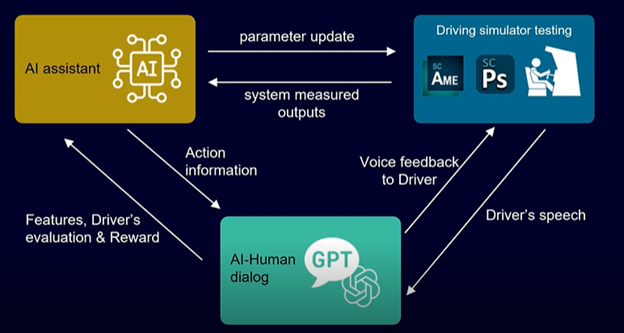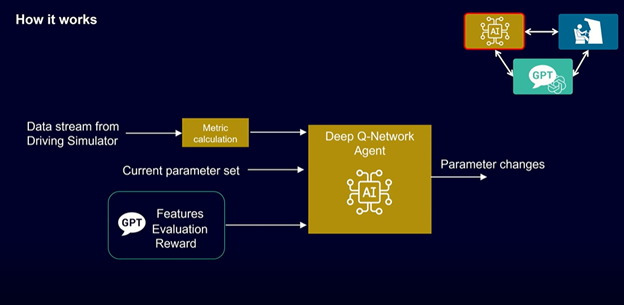Driving into the future: Exploring the integration of ChatGPT and AI in vehicle development

On November 30, 2022, ChatGPT was released to mixed response. To some, it marked a new era of AI – one that would revolutionize the way we use the internet, conduct research, and develop content. To others, it raised serious concerns about privacy, job loss, and misinformation.
Although the ethics of ChatGPT are under fierce debate, its underlying technology – large language models (LLMs) – represents enormous opportunity for efficiency gains in engineering. Recently, the Simcenter Engineering Services team decided to put ChatGPT to the test and explore its value for the vehicle development process.
Using AI for vehicle ride and handling attribute balancing
Optimizing vehicle ride and handling attributes is a complex, time-consuming phase in the development process. When one attribute is changed, it often impacts the performance of other components and requires extensive testing and parameter adjustment. The traditional approach involves quantifying the subjective experiences related to the ride and handling, followed by the utilization of simulation tools to refine and perfect these attributes. However, this method is not always efficient. Personal preferences are inherently complex and difficult to translate into objective parameters.
Spontaneous speech, on the other hand, is a natural way of expressing product perception in real time while a user is interacting with the product. Recent developments in LLMs, especially ChatGPT, make it possible to process such inputs. Our engineering team decided to explore whether ChatGPT could be combined with system simulation to help engineers make better use of subjective feedback to improve ride and handling in vehicles.

Combining AI, ChatGPT and Simcenter Amesim
An AI assistant, developed by the Simcenter Engineering Services team, lies at the core of this project. This assistant, leveraging technology of Reinforcement Learning with Human Feedback (RLHF), plays a pivotal role in getting information about both product and human and generating corrections in the product. It uses ChatGPT as a “translator” to bridge the interaction gap between human and AI.
In this case, the product was a car represented by the Simcenter Amesim vehicle dynamics model running on a driving simulator with Simcenter Prescan providing the environment visualization. The AI assistant, running in the background, would continuously learn about the driver’s preferences and the sensitivity of the driver’s subjective perception to vehicle parameter changes. Here’s how it works:
Using the technology developed by the Simcenter Engineering Services team, the test engineer can perform maneuvers on a driving simulator.
How does it work?
While executing maneuvers, the driver provides feedback on the experience. The verbal input is transformed into text and relayed to ChatGPT for analysis. Specifically guided by a contextual framework, ChatGPT is tasked with extracting some key elements from the driver’s speech such as features (ex.: yaw response, vertical acceleration, etc) and their characteristics (ex.: high or very high, low, etc) and understanding the driver’s emotional response. In cases where clarity is needed, ChatGPT engages in ongoing dialog with the driver until the necessary details are clarified. When required information is obtained, our Reinforcement Learning-based AI assistant generates changes in the system parameter set.

Possible applications of ChatGPT integration with Simcenter
While the focus of this project was on car ride and handling attributes balancing, the application of this technology extends to a variety of other areas of product development.
For test engineers, a test driver’s vocal commands could be used to collect subjective feedback and make modifications to specific events. Simulation engineers could use it to remedy unsatisfactory experiences with the software. Nearly every aspect of vehicle engineering that requires subjective thoughts and feelings could be enhanced and optimized by the technology developed by our engineering team.
Despite the controversy surrounding ChatGPT, engineering teams have been given a unique opportunity to easily convert the uncertainty and variability of subjective feelings to actionable, quantifiable, and objective parameter changes to improve vehicle handling for drivers. The question is, which companies will be the first to embrace it?
The Simcenter Engineering Services team consists of hundreds of talented engineers across the world. The team members who are pioneering the use of ChatGPT in our simulation products include:
Click here to listen to Yerlan and Sarah discuss this project in the Engineer Innovation podcast.
You may also enjoy:
- The potential impact of Large Language Models (LLMs) on Computer Aided Engineering
- How to use AI to reduce the Parameter ID process from weeks to minutes
- Making your historical NVH data work for you
- 4 Myths about AI in CFD
- MAB in engineering: A Hyundai Motor Company case study
- Hyundai Motor Group uses AI to reduce the parameter optimization process from one week to 15 minutes



